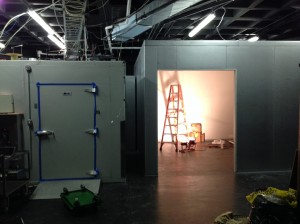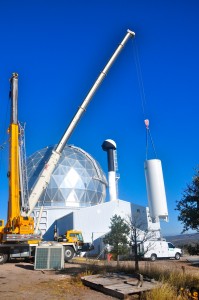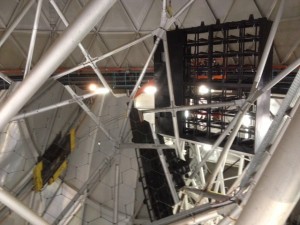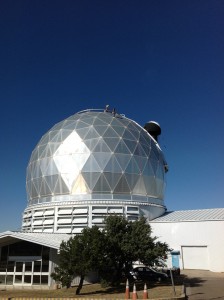The biggest change the occurred this week was the completion of the HPF enclosure. A team came out from Penn State to lead the efforts and after two days the enclosure was completed and the last day was spent wiring up temperature sensors to monitor how the systems reacts to seasonal changes in the HET basement.
Our electrical team completed hook up of power cables to distribution boxes in Virus annex this week. They hoisted and installed the Virus equipment rack in the annex as well. We hope to have all of the electrical work done for the first enclosure by the end of next week when a programmer comes from Austin work work on the PLCs.
This week we found a problem with loose screws on lower X. We shut the tracker down for the week and an engineer came out from Austin to inspect the system for any damage. He found that many of the screws were loose and some of the shims were missing. This was likely caused by a fairly strong vibration incident that we had when we were commissioning the TCS timing loops. The engineers and mechanical team got the X drive shimmed and aligned again and all of the crews have been tightened down with torque wrenches. While the engineer was out here he worked on the rho stage which was hitting the proximity sensors early due to the non-flatness of the switch plate. They re-installed it with shims to adjust flatness and installed RHO limit switches and set the clearance.
The initial commissioning of the Strip and Wash Room began this week. A mirror segment was put through the new ultra-pure water cleaning. It is not entirely surprising that a number of small leaks were found around the mirror and passage way doors. The rest of the week was spent finding leaks and diverting water drainage paths. Our electrical engineer has nearly completed the PID controller and pressure display that will show when the room is in positive pressure and negative pressure.
As an interesting diversion this week we had the Director on site with several photographers taking pictures of him and the facility. Some of the shots were done from a helicopter while others were done from various catwalks or man-lifts. We all look forward to seeing these glamour shots.




